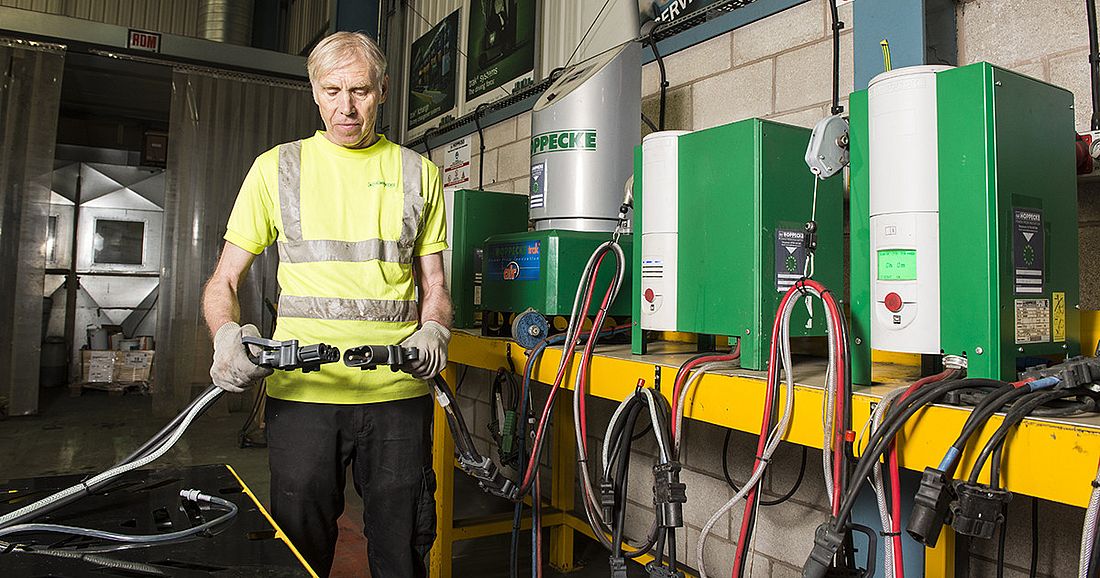Logistics businesses are having to adapt to stringent Covid-19 restrictions and revised working patterns. For MHE fleet managers however, the aim remains the same. Get the job done, but keep costs down.
A forklift battery and charger account for 20% to 25% of truck cost. It’s therefore important to make a sound investment. So, how to achieve a cost-effective battery and charger solution?
Here are ten key points to consider:
1. Operational impact on battery capacity
The type of logistics operation is important. To specify the correct capacity first assess hours of use per truck each day. Then check how many days each truck is in use each week. Look into ground and floor conditions, including ramps or inclines. Consider the temperature of the working area. Assess how much weight will be lifted and the height of lift. Finally, work out the length of runs, both loaded and unloaded.
2. MHE operation dictates power efficiency
Power efficiency depends on how MHE operates. Consider that a reach truck is more power efficient on lift than travel. It’s the opposite for counterbalance forklift. Meanwhile, power pallet trucks and VNA bulk loaders are equally power efficient on travel and lift.
3. Choice of charger technology
To achieve a cost-effective battery and charger solution it’s important to specify the right charger. There are two technologies. Transformer type standard 50Hz chargers are unregulated. High frequency (HF) chargers are regulated smart chargers. Generally, both technologies are readily available. Both offer a choice of 12-hour or 8-hour recharge.
4. Cheaper isn't better
At the outset, a 50Hz charger is cheaper to buy. Yet it is larger and heavier than the high frequency option. Depending on manufacturer it is also only 60-80% efficient. The charger controls the battery requirements necessitating higher input amps. It needs a type D slow acting RCD/Fuse.
By comparison, the initial price of the HF charger is higher. This is countered by lower running costs. It is smaller and lighter. Importantly, efficiency is 85-95%. A key advantage is its lower battery electrolyte filling requirements. The HF charger works equally well off a 50Hz or 60Hz AC supply. During the recharge cycle the battery controls the charger, requiring lower input amps. At Soft Start it works with a standard B or C RCD/Fuse.
5. Available hours
The number of continuous hours available to recharge batteries influences the charger specification. Standard lead-acid batteries need a full charge and at least an hour of cooling time. Put simply, that’s 13 hours between battery connection and disconnection for a 12-hour charger.
6. Productivity levels
Don’t base your choice of charger on existing productivity levels alone. As the Covid-19 pandemic has taught us, targets can change at short notice. It’s always best practice to consider future production needs. Significant business growth could render a 12-hour charger that’s working well now unfit for purpose in five years.
7. Operational set-up changes
Looking ahead, consider how the nature of your operation could alter. Perhaps you’re planning to multishift? Investing in spare batteries is one solution. Alternatively, you could switch to organised opportunity charging. To achieve a cost-effective battery and charger solution, discuss your options.
8. Electrical supply
Is your electrical supply single phase 230v/250v or three phase 400v/415v supply? Standard and HF chargers are available in both options. Bear in mind that HF chargers are designed for European markets. Consequently, they are more common in 48 volt and 80-volt configuration for 400/415-volt supply. Also take into account any existing AC amp restrictions of supplies.
9. Safety first
Always treat lead-acid batteries with respect. Remember that during recharge they generate and vent hydrogen and oxygen gasses. A spark or naked flame coming into contact with an acid concentration above 4% cause an explosion. For safety’s sake open all lids when batteries are on charge. Also, ensure that reach truck batteries are reached out and opened. This will allow the gasses to rise and disperse into the free air around the equipment. Use either natural or forced ventilation to reduce the hydrogen concentration and keep the level in this free air to below 2%.
10. Temperature of the working area
Remember to take account of the temperature in the working area. Lead-acid battery capacity can reduce by up to 25% in cold store facilities. Since the low temperature of the electrolyte affects its viscosity during recharge, the battery voltage rises quicker than the specific gravity. Standard 50Hz chargers switch off when voltage is reached, so the specific gravity doesn’t recover sufficiently to support the operation. HF chargers are therefore more suitable for such applications. Ideally, to improve the availability of battery capacity, use them in conjunction with a battery-controlled temperature probe.
As we can see, a number of factors are in play. That’s why it makes sense to seek advice to ensure a sound investment. Call us today to discuss a cost-effective battery and charger solution for your MHE application.
